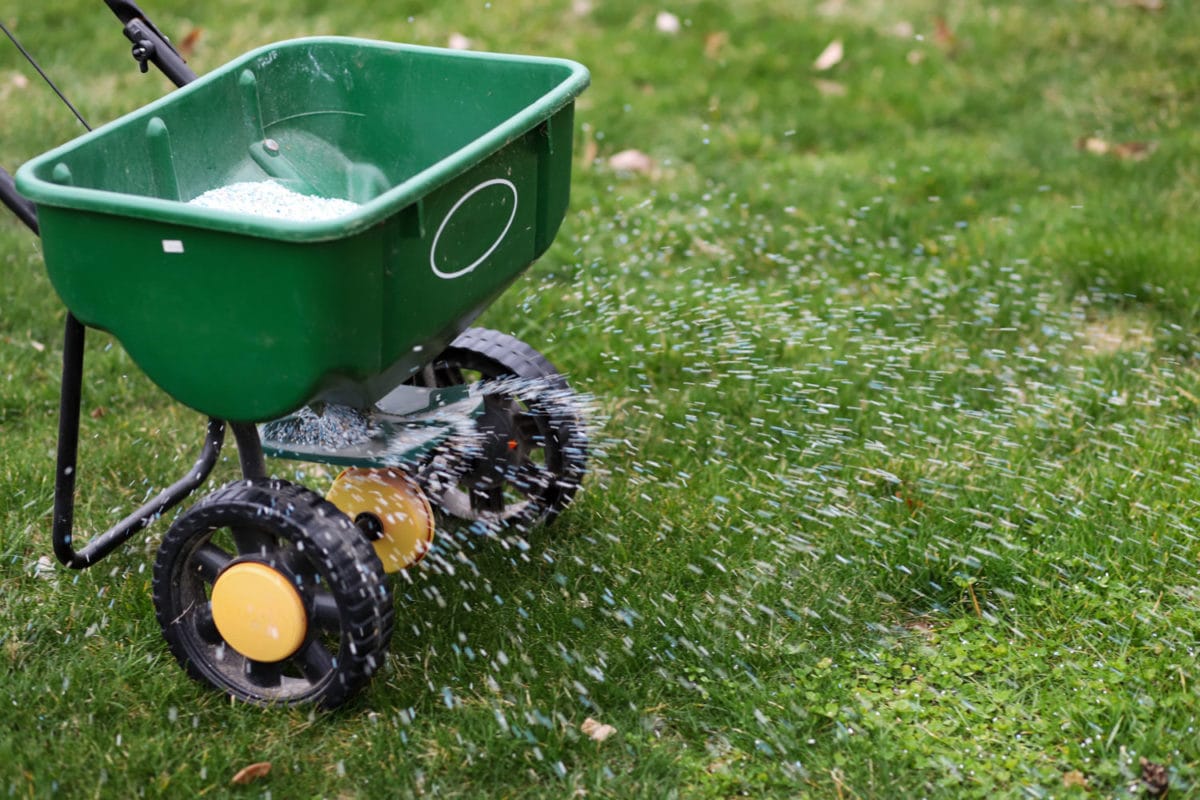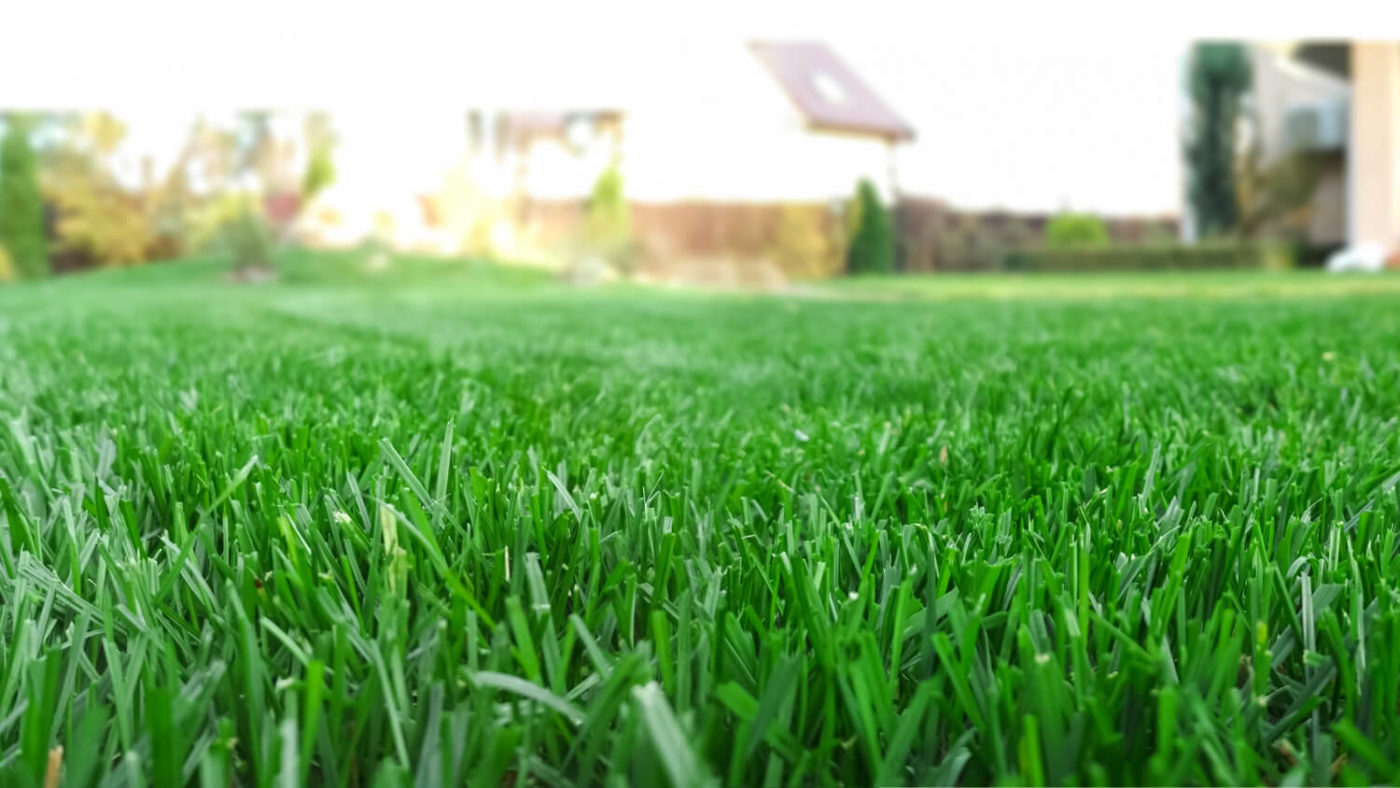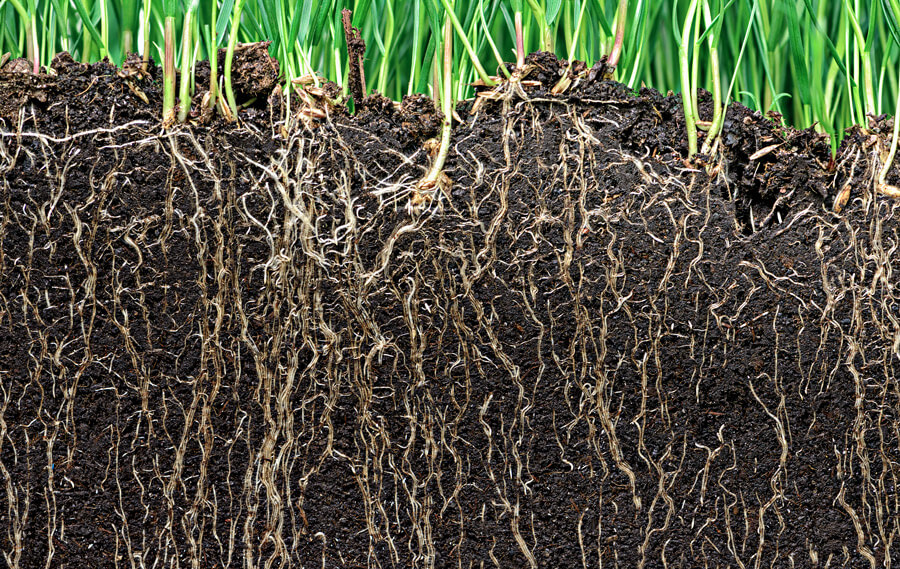For a perfect lawn, should should be feeding the soil and grass all year round, but what kind of fertiliser does your lawn need, and why? Read my beginners guide to lawn feeding.
Deciding what kind of fertiliser to apply to your lawn can seem a little overwhelming. There are so many different types to choose from.
In this article, I’m going to try and help you see past the marketing hype and choose the most cost effective and reliable lawn feed for your lawn. Let’s start with a science lesson.

Why Do Grass Plants Need Fertiliser?
Every living thing needs nutrition. From microscopic bacteria to blue whales and massive oak trees, without the building blocks for energy, growth and reproduction, the cycle of life would come to a grinding halt. But what about grass? I hear you say. It can survive in the cracks in the pavement without anyone feeding it, so why do I need to feed my lawn?
Well, take a walk down the street and peep into a few gardens. There’s a big difference between the appearances of lawns where the grass is surviving and lawns where the grass is thriving. Lots of factors will be involved, but to my mind, one of the top 3 influences on a lawn’s appearance is feeding. (The other two are mowing and sunshine).
Here’s the thing. You’ll probably know from experience that people and pets who are recovering from illness or accident require much better nutrition than ‘normal’ so that their bodies can repair themselves.
To create a lovely lawn, you are effectively damaging the grass plants once or twice a week throughout the growing season. You cut off 1/3 of the grass blades and take away one of the main sources of energy. So, it follows, that your lawn will need tip top nutrition if it is not to be weakened by regular mowing.
Mother Nature is very clever at providing enough nutrients for plants to just survive . However, if you want your lawn to be lush and green with a velvety texture, rather than looking like a shaved road verge, you need to figure out a lawn feeding regime and stick with it.

A well fed lawn is a joy to behold
What Nutrients Does My Lawn Need?
Just like you and me, lawns need a healthy balance of nutrients. Too much of one thing and they’ll grow big but not strong. Too little of another and the plants may be more susceptible to diseases.
We need water, protein, fat, carbohydrates and a selection of vitamins and minerals. Each of those food groups has a different function in our bodies. Plants, too have a list of ‘must have’ nutrients, including
- Nitrogen for strong and rapid growth
- Phosphorus for healthy root growth
- Potassium for resistance to disease, drought, and cold
- Iron – an important constituent in chlorophyll which makes grass look green
- Sulphur – helps make protein and activates certain enzymes within the plant
- Calcium – builds strong cell walls and helps unlock nutrients from the soil
- Magnesium – Used during photosynthesis, protein formation and energy transfer
- Trace Elements such as copper, boron, zinc and molybdenum – equivalent to our vitamins and minerals
All of these elements have an important role to play in the health of the plant. Some of these elements are only needed in minuscule amounts, and there’s enough of them in the soil to support your plants. Others get used up quickly and need to be replenished.
Making Nutrients Accessible To Plants
A balanced meal for a person would consist of a mixture of protein rich foods (eg meat or beans), carbohydrate rich foods (eg chips) and vegetables for vitamins and fibre. As soon as we start eating, our digestive system sets to work breaking those foods down into chemical elements. In other words, atoms which form the building blocks to make cells, hormones, etc Anything our bodies can’t use is excreted.
Plants don’t have a digestive system. They absorb the compounds and atoms they need through microscopic pores on their roots and leaves. Whist we can travel to find food, plants are stuck in one place – they can spread their roots and they can grow their leaves towards the sun (their source of energy) but they can’t nip to the chippy.
So, everything the grass plants need must be within easy reach of their roots or leaves, and it must be in a format that the plant can absorb.
Just to throw a spanner in the works. Most plant nutrients dissolve in water, which means that they can move around in the soil and ’float’ towards the roots where they are needed. It also means that they can be washed away as excess water drains out of the soil. Another reason that we need to a) Keep topping up the nutrient levels in the soil. And b) avoid applying too many nutrients at once, (because there is the potential for them to upset the ecological balance in our waterways)
Finally, some types of soil contain naturally occurring atoms that like to attach to our plant food atoms, thus making them too big for the roots to absorb and effectively ‘locking’ the nutrients into the soil. Again, applying fertiliser little and often and/or using foliar feeds is the way to make sure your grass plants get what they need.

Getting the right balance of nutrients and the right time of year helps to develop strong roots and healthy grass plants.
Timely Applications
Going back to the world of human anatomy now for another analogy. We’re talking about babies, young children and mum’s to be and folks recovering from illness or injury. All of these people need to adjust the balance of nutrients they take according to their growth rate.
Grass plants have varying growth rates too – only the number of new cells they need to make changes according to the time of year.
So now we need to factor in to your lawn feeding regime, the fact that nutritional needs will change with the seasons.
In spring for example, the plants want to grow tall and set seed. We are forever mowing them down again so they need to replace the vegetation we’ve taken. They needs lots of nitrogen for growth and some iron to rebuild the chorophyll molecules that sit in the leaves and harvest energy from the sun.
In winter, the plants just want to survive the cold and prepare themselves for rapid growth in the spring. They put their energy into growing roots, and for that they need plenty of phosphorus, but not so much Nitrogen.
What To Feed Your Lawn Each Season
When you go to the garden centre to buy lawn feed, you’ll find three numbers on the packet. Usually something like 18:3:8 or 15:5:20. These represent the proportions of the three most important nutrients; Nitrogen (N), Phosphorus (P) and Potassium (K). You might see or hear them referred to as NPK.
For spring and summer, you need high Nitrogen, and a moderate amount of phosphorus and potassium to balance it. (Feeding one nutrient without the others is like eating junk food, plants might grow fast but they won’t necessarily be healthy)
For autumn and winter, the plants need less nitrogen than in summer but more phosphorus and potassium. Feeding too much nitrogen in winter time does tend to encourage lush, sappy growth that is vulnerable to common lawn diseases.
Some lawn feeds will also contain micro nutrients – the iron, sulphur, magnesium etc that plants need in smaller amounts. Look out for these feeds if you can. They may cost you a little more money but it will be worth it.
Follow the manufacturers recommendations to the letter when applying lawn feed. As you gain experience you may feel confident to experiment a little but please don’t even think about exceeding the recommended rates – too much fertiliser can really damage your lawn and do an enormous amount of harm to the environment at the same time.
I also advise supplementing your lawn feed with a regular dose of a seaweed tonic. It contains many of the micronutrients that tend to get locked up in the soil and because it’s absorbed through the leaves, you can be certain that your lawn does actually receive the goodness it needs to thrive.
Finally – if you REALLY want an amazing lawn – watch this video to discover my secret sauce.
Buy seaweed tonic to give your lawn a boost
How to prepare your lawn for summer.
How often should you apply lawn treatments?

